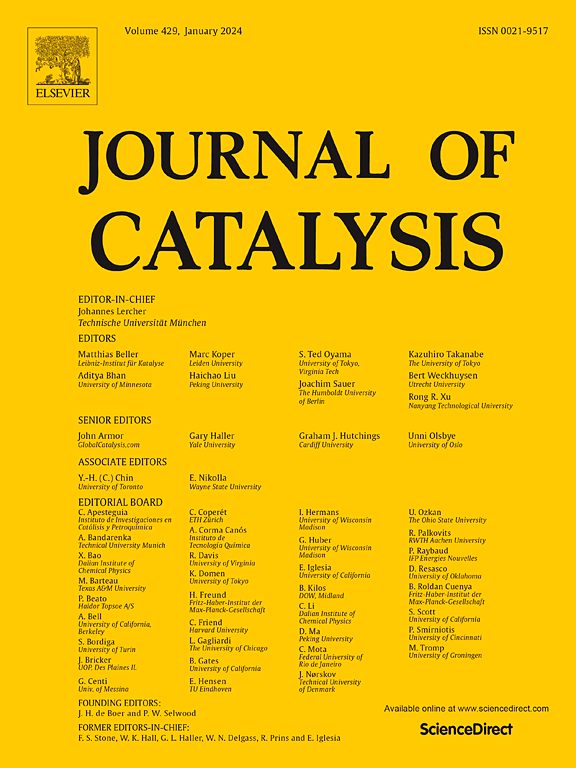分子氧催化银催化丙烯环氧化过程中的共启动子相互作用
IF 6.5
1区 化学
Q2 CHEMISTRY, PHYSICAL
引用次数: 0
摘要
促进银催化剂上的丙烯环氧化需要几种促进剂,包括氯丙烯(5-20 ppm)、一氧化氮(100-1000 ppm)和二氧化碳(2-10 vol%)在k促进银/CaCO3上的气体共进料。相对于单个启动子浓度的稳态速率和选择性趋势表明,除了启动子对氧化中间体的直接影响外,共启动子还显著改变了其他共启动子作用的性质和强度。在K促进的Ag/CaCO3上,一氧化氮在低浓度(取决于K负载,高达 ~ 100 ppm NO)下增加环氧化选择性,而在较高浓度(>200 ppm NO)下降低选择性。共同促进的K浓度显著影响选择性氧化所需的NO浓度,证明了NO和K的协同共同促进作用。在低K/NO促进水平下,二氧化碳(0.2-40 vol%)弱抑制O2激活率(~ 0.3阶抑制)并抑制选择性,而在高K/NO促进水平下,共同供气的CO2增加选择性并达到最大阶抑制率( ~ 0.5阶抑制)。这些结果可以在选择性增强、竞争碱稳定的NOx和/或COx的基础上得到合理的解释。在k促进催化剂上,NO对稳态速率有半阶促进作用,瞬态实验表明,NO缓慢生成与氧化和氯化催化活性相关的长寿命表面中间体,这与NO生成增强活性的共催化NOx中间体或去除表面中毒的碱稳定COx物质以提高催化活性相一致。K促进作用(>0.05 mol K (mol Agbulk)−1)也显著改变了共投料氯丙基的促进作用,其中K裸催化剂对有机氯的选择性促进作用明显减弱。对共启动子相互作用的深入研究表明,选择性丙烯环氧化仅发生在由CO2和NOx产生的碱稳定氧离子以及促进Cl的适当浓度覆盖的活性位点上。本文章由计算机程序翻译,如有差异,请以英文原文为准。

Co-promoter interactions within silver-catalyzed propylene epoxidation by molecular oxygen
Propylene epoxidation on promoted Ag catalysts requires several promoters including gaseous co-feeds of allyl chloride (5–20 ppm), nitric oxide (100–1000 ppm), and carbon dioxide (2–10 vol%) on K-promoted Ag/CaCO3. Steady-state rate and selectivity trends with respect to individual promoter concentrations reveal, in addition to direct influence of promoters on oxidation intermediates, co-promoters significantly alter the nature and magnitude of the effect of other co-promoters. On K-promoted Ag/CaCO3, nitric oxide increases epoxidation selectivity at low concentrations (depending on K loading, up to ∼100 ppm NO) and decreases selectivity at higher concentrations (>200 ppm NO). Co-promoting K concentrations significantly influence the concentrations of NO required for selective oxidation, evincing cooperative co-promotional effects of NO and K. At low levels of K/NO promotion, carbon dioxide (0.2–40 vol%) weakly inhibits O2 activation rates (∼0.3 order inhibition) and inhibits selectivity while at high levels of K/NO promotion, co-fed CO2 increases selectivity and reaches maximal order inhibition of rates (at ∼0.5 order inhibition). These results can be rationalized on the basis of selectivity-enhancing, competing alkali-stabilized NOx and/or COx derived from co-fed NO and CO2. NO renders half-order promotion of steady-state rates on K-promoted catalysts, and transient experiments show NO slowly generates long-lived surface intermediates relevant to catalytic activity for both oxidation and chlorination—consistent either with NO generating an activity-enhancing, co-catalytic NOx intermediate or removing surface-poisoning, alkali-stabilized COx species to promote catalytic activity. K promotion (>0.05 mol K (mol Agbulk)−1) is also shown to substantially alter the promoting action of co-fed allyl chloride, with K-bare catalysts featuring significantly weaker selectivity promotion by the organochloride. Insights into co-promoter interactions suggest selective propylene epoxidation occurs only on active sites covered in appropriate concentrations of alkali-stabilized chlorine and oxyanions derived from CO2 and NOx.
求助全文
通过发布文献求助,成功后即可免费获取论文全文。
去求助
来源期刊

Journal of Catalysis
工程技术-工程:化工
CiteScore
12.30
自引率
5.50%
发文量
447
审稿时长
31 days
期刊介绍:
The Journal of Catalysis publishes scholarly articles on both heterogeneous and homogeneous catalysis, covering a wide range of chemical transformations. These include various types of catalysis, such as those mediated by photons, plasmons, and electrons. The focus of the studies is to understand the relationship between catalytic function and the underlying chemical properties of surfaces and metal complexes.
The articles in the journal offer innovative concepts and explore the synthesis and kinetics of inorganic solids and homogeneous complexes. Furthermore, they discuss spectroscopic techniques for characterizing catalysts, investigate the interaction of probes and reacting species with catalysts, and employ theoretical methods.
The research presented in the journal should have direct relevance to the field of catalytic processes, addressing either fundamental aspects or applications of catalysis.
 求助内容:
求助内容: 应助结果提醒方式:
应助结果提醒方式:


